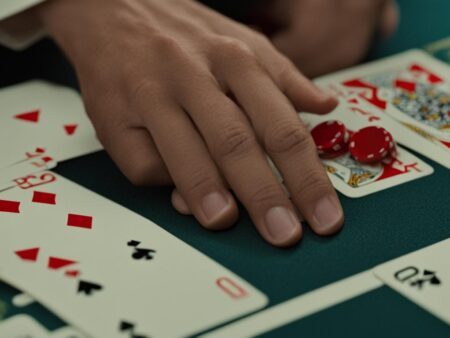Welcome to our comprehensive guide on mastering the blackjack surrender hand signal. In this article, we will delve into the importance of hand signals in blackjack, specifically focusing on the surrender hand signal. Hand signals are not only a universal language in the world of blackjack but also a crucial aspect of effective communication between players and dealers. By mastering the surrender hand signal, you can navigate the game with confidence and make strategic decisions to maximize your chances of winning.
Key Takeaways:
- Understanding hand signals in blackjack is essential for clear communication during gameplay.
- The surrender hand signal allows players to withdraw from the current hand and forfeit half of their bet.
- Proper use of hand signals in blackjack enhances fairness and maintains the pace of the game.
- The surrender hand signal should be used strategically, considering the player’s cards and the probability of winning the hand.
- Mastering hand signals in blackjack contributes to an enjoyable and efficient casino experience.
Understanding the Hand Gestures in Blackjack
In the game of blackjack, hand gestures play a crucial role in communication between players and dealers. These universal hand signals allow players to indicate their intended moves without the need for verbal communication, ensuring a smooth and efficient gameplay experience. By understanding and proficiently using these hand gestures, players can enhance their gameplay and minimize miscommunication.
One of the most common hand gestures in blackjack is the hand signal for a hit, which indicates the player’s desire to receive an additional card. Players can tap the table or point to their cards when they are face up to signal a hit. However, when the player’s cards are face down, they should scrape their card hand across the table twice to indicate a hit.
Another important hand gesture in blackjack is the surrender hand signal. This gesture allows players to indicate their desire to give up half of their bet and withdraw from the current hand. Players can draw a short line under their cards with their finger when the cards are face up, or draw a line from left to right over their cards when they are facing down to signal surrender.
It is important to note that these hand signals are universal and apply to both classic blackjack and other variants of the game. Understanding and using these hand gestures not only ensures clear communication, but also adds to the overall casino experience, particularly in multicultural environments where players and dealers may have different languages and communication styles.
Understanding the Hand Gestures in Blackjack
Signaling Surrender in Blackjack
In the game of blackjack, knowing when to surrender can be a strategic decision that can save you from losing your entire bet. To effectively signal surrender in blackjack, there are two commonly used hand gestures and a verbal option that players can choose from.
The first hand gesture involves drawing a short line under your cards with your finger when they are face up. This simple motion indicates to the dealer that you wish to surrender and receive half of your bet back. If your cards are facing down, you can draw a line from left to right over your cards to signal surrender.
Alternatively, some players may choose to surrender verbally, stating their decision clearly to the dealer. Verbal surrender eliminates any ambiguity or confusion and ensures that your intention to surrender is properly communicated.
When to Surrender in Blackjack
Knowing when to surrender in blackjack is just as important as knowing how to signal it. It is generally recommended to surrender when your chances of winning the hand are low, and the risk of losing the entire bet is high. The most common scenario is when you have a hard 16 (a hand with a total of 16 without an Ace) against a dealer’s strong upcard, such as a 9, 10, or Ace.
Surrendering in this situation allows you to cut your losses and salvage half of your bet rather than risking losing it all. However, it’s important to note that surrendering is not always the best option, as there are instances where it is more favorable to hit, stand, or double down.
Understanding the surrender hand signal and when to use it can significantly impact your blackjack gameplay and improve your chances of success at the table.
Doubling Down Hand Signal in Blackjack
In blackjack, the double down hand signal is used to indicate the player’s intention to double their bet and receive one additional card. This strategic move can significantly increase the player’s potential winnings when used correctly. Understanding how to signal a double down and knowing when to utilize this option can greatly enhance your blackjack gameplay. Let’s explore the hand signal for double down, how to execute it, and when it’s advantageous to double down in blackjack.
When signaling a double down in blackjack, players can use specific hand gestures to convey their intention to the dealer. If the player’s cards are face up, they can lay two touching chips on the table and point to their cards. This gesture clearly communicates to the dealer that the player wants to double their bet and receive one more card. On the other hand, if the player’s cards are face down, they should turn their cards over, add an additional bet, and raise a finger. This hand signal lets the dealer know that the player wishes to double down and is ready to receive an additional card.
Knowing when to double down is crucial for maximizing your chances of winning in blackjack. This strategy is typically employed when the player has a strong hand and believes that their next card will give them a high probability of beating the dealer’s hand. Generally, it is recommended to double down when the player has a hand value of 9, 10, or 11, as these values provide a better chance of improving the hand with one more card.
However, it’s essential to consider the dealer’s upcard when deciding whether to double down. If the dealer has a weak upcard, such as 2 through 6, it may be more advantageous to double down. Conversely, if the dealer’s upcard is strong, like 7 through Ace, it may be wiser to refrain from doubling down. By carefully analyzing the cards on the table and evaluating the dealer’s upcard, you can make informed decisions on when to utilize the double down hand signal in blackjack and increase your chances of success.
Table: Doubling Down Hand Signal Guide
| Situation | Hand Signal |
|---|---|
| Player’s cards face up | Lay two touching chips and point to cards |
| Player’s cards face down | Turn cards over, add additional bet, and raise a finger |
Tapping the Table in Blackjack
One of the most common hand signals in blackjack is tapping the table, which indicates a player’s desire to receive an additional card, also known as a hit. When a player’s cards are face up, they can tap the table or point to their cards to signal a hit. This is a universal gesture that is easily understood by both dealers and fellow players. Tapping the table is a quick and efficient way to communicate the player’s intentions without the need for verbalizing their decision.
It is important to note that when a player’s cards are face down, the hand signal for a hit is slightly different. In this case, the player should scrape their card hand across the table twice to signal a hit. This distinct gesture ensures that there is no confusion between tapping the table for a hit and other hand signals, such as doubling down or splitting.
The purpose of tapping the table in blackjack is to increase the total value of the player’s hand. By requesting additional cards through this hand signal, players aim to improve their hand’s chances of winning or achieving a total closer to 21 without exceeding it. Tapping the table is a fundamental part of blackjack gameplay and is essential for players to effectively communicate their desired moves at the table.
| Hand Signal | When Cards are Face Up | When Cards are Face Down |
|---|---|---|
| Tapping the Table | Tap the table or point to the cards | Scrape the cards across the table twice |
| Double Down | Place extra chips next to the initial bet | Turn over the cards, add an additional bet, and raise a finger |
| Split | Place additional chips next to the initial bet | Turn over the cards, add an additional bet, and separate the cards |
| Surrender | Draw a short line under the cards | Draw a line from left to right over the cards |
Importance of Hand Signals in Blackjack
The use of hand signals in blackjack is crucial for several reasons. Firstly, hand signals serve as a universal language that allows clear communication between players and dealers, ensuring that there are no misunderstandings or misinterpretations of players’ intentions. By using specific hand signals for actions such as hitting, standing, doubling down, splitting, and surrendering, players can effectively convey their desired moves without the need for verbal communication.
Hand signals also play a significant role in maintaining the rhythm and speed of the game. In a fast-paced casino environment, where multiple players are participating in the same game, hand signals enable a seamless flow of gameplay. By using hand signals, players can make their decisions quickly and efficiently, saving time and ensuring that the game progresses smoothly.
Another advantage of using hand signals in blackjack is that they provide assistance to novice players. More experienced players can observe and interpret the hand signals used by others, allowing them to step in and offer guidance if they notice any incorrect or unclear signals. This helps create a supportive and collaborative atmosphere at the blackjack table, promoting a positive gaming experience for all players involved.
Advantages of Hand Signals in Blackjack:
- Clear communication between players and dealers.
- Efficient gameplay and faster decision-making.
- Assistance for novice players from more experienced players.
- Enhancement of fairness and elimination of miscommunication or foul play.
- Maintaining the pace and flow of the game.
In summary, hand signals in blackjack serve a vital role in facilitating effective communication, maintaining the pace of the game, and providing assistance to players. By understanding and utilizing these signals, players can enhance their gameplay experience, communicate their intentions clearly, and contribute to a fair and enjoyable blackjack environment. Mastering the art of hand signals is a valuable skill for any blackjack player, whether they are a beginner or an experienced gambler.
Hand Signals in Classic Blackjack

Classic blackjack, a popular variant of the game, utilizes specific hand signals to convey players’ desired moves. These hand signals are essential for effective communication with the dealer and other players at the table. Here, we will explore how to use these hand signals in face-up and face-down blackjack scenarios.
Face-Up Blackjack Hand Signals
In face-up blackjack, players have their initial cards dealt face up on the table. To signal a hit, players can tap the table or point to their cards. A wave of the hand over the chips indicates a stand, while placing additional chips next to the initial bet signifies a double down or a split. Mastering these hand signals ensures smooth gameplay and efficient communication during face-up blackjack.
Face-Down Blackjack Hand Signals
Face-down blackjack involves dealing the initial cards face down, requiring players to handle their cards differently. To signal a hit in face-down blackjack, players should scrape their card hand across the table. Moving the cards under the chips indicates a stand. For a double down or a split, players need to turn over their cards, add an extra bet, and raise a finger. Understanding and using these hand signals correctly is crucial for effective gameplay in face-down blackjack.
| Hand Signal | Face-Up Blackjack | Face-Down Blackjack |
|---|---|---|
| Hit | Tap table or point to cards | Scrape cards on the table |
| Stand | Wave hand over chips | Move cards under chips |
| Double Down or Split | Place additional chips next to initial bet | Turn over cards, add extra bet, and raise a finger |
By familiarizing yourself with the hand signals for classic blackjack, you can effectively communicate your moves and ensure a smooth and enjoyable gaming experience at the blackjack table.
Hand Signals in Surrender Multi-Hand Blackjack
In surrender multi-hand blackjack, special hand gestures are used to communicate various moves to the dealer. These hand signals include the traditional gestures for hitting, standing, doubling down, and splitting, as well as the unique surrender hand signal. Mastering these signals is essential for effective gameplay and strategic decision-making in this variant of blackjack.
When it comes to surrendering in surrender multi-hand blackjack, players can use a specific hand signal to indicate their intention. To signal surrender, players should draw a line behind their bet with their index finger. This gesture clearly communicates the player’s desire to surrender and opt out of the current hand, allowing them to recoup half of their bet.
Additionally, players should be familiar with the hand signals for hitting, standing, doubling down, and splitting. These gestures are the same as in traditional blackjack and are universally recognized in casinos. Using these signals ensures that there is no confusion or miscommunication between the player and the dealer, creating a smoother and more efficient gaming experience for everyone involved.
To summarize, hand signals play a crucial role in surrender multi-hand blackjack by enabling clear communication with the dealer. The unique surrender hand signal, along with the traditional gestures for hitting, standing, doubling down, and splitting, allow players to effectively convey their desired moves. By mastering these signals, players can enhance their gameplay and make informed decisions, ultimately increasing their chances of success in surrender multi-hand blackjack.
| Hand Signal | Description |
|---|---|
| Surrender | Draw a line behind the bet with the index finger. |
| Hit | Tap the table or point at the cards to signal a hit. |
| Stand | Wave the hand over the chips to indicate standing. |
| Double Down | Lay two touching chips and point to the cards, or turn over the cards, add an additional bet, and raise a finger. |
| Split | Place extra chips next to the initial bet to signal a split. |
The Importance of Using Hand Signals in Blackjack
Using hand signals in blackjack provides numerous advantages that contribute to a smooth and fair gameplay experience. The communication aspect of the game is greatly enhanced through the use of hand signals, ensuring that both players and dealers understand each other’s intentions without any confusion. Hand signals serve as a standard form of communication in the game, eliminating the possibility of miscommunication or misunderstandings. They also help in maintaining the pace and flow of the game, making the gameplay more efficient and enjoyable for all.
One of the key advantages of using hand signals is that it promotes fairness and prevents cheating. By utilizing hand signals, players are able to clearly communicate their desired moves without relying on verbal cues that may be prone to manipulation or misinterpretation. Additionally, casinos often have security cameras that monitor gameplay, and hand signals provide a clear record of players’ actions, ensuring that the game is played in a fair and transparent manner.
Another advantage of hand signals is that they help protect the interests of both players and casinos. By establishing a standard form of communication, hand signals ensure that all players have equal opportunities to make their moves and that the gameplay is conducted in a consistent and orderly manner. Hand signals also help dealers in accurately interpreting players’ intentions, reducing the chances of disputes or disagreements at the table. Overall, using hand signals in blackjack creates a level playing field for everyone involved and contributes to a positive gaming atmosphere.
In conclusion, hand signals play a crucial role in the game of blackjack. They enhance communication, promote fairness, and maintain the pace of the game. By utilizing hand signals, players can ensure that their actions are accurately understood by dealers and fellow players, creating a harmonious gaming environment. Whether playing in a physical casino or online, mastering the proper use of hand signals is essential for a successful and enjoyable blackjack experience.
Rules and Etiquette for Live Blackjack

In live blackjack, it is important to adhere to certain rules and etiquette to ensure a smooth and enjoyable gaming experience for all players. By following proper behavior, players can maintain a respectful and fair environment at the table. Here are some key rules and etiquette guidelines to keep in mind:
Limited use of hands:
When playing live blackjack, players should avoid holding their cards with two hands. This is to prevent any suspicion of cheating or manipulating the cards. Each player should handle their cards with one hand only, ensuring transparency and fairness in the game.
Respect for fellow players:
It is crucial to show respect and consider the comfort of other players at the table. Unsolicited advice or criticism can disrupt the flow of the game and create a tense atmosphere. Instead, focus on your own gameplay and refrain from interfering with others unless asked for assistance.
Keeping cards visible:
To maintain transparency and fairness, players should always keep their cards on the table and avoid covering them with their hands. By keeping the cards visible, dealers and other players can clearly see if any incorrect moves or actions are made, ensuring a fair and honest game.
Use of hand signals:
In live blackjack, it is customary to use hand signals to indicate your desired moves instead of verbalizing them. This helps to avoid confusion and miscommunication between players and dealers. Learn and use the appropriate hand signals for actions such as hitting, standing, doubling down, and splitting.
Proper chip handling:
When placing bets or making additional wagers, it is important to handle your chips in a respectful and organized manner. Avoid splashing the pot by throwing chips carelessly, as this can cause confusion and slow down the game. Instead, neatly place your chips in the designated betting area.
Respecting the dealer:
Show respect and courtesy towards the dealer throughout the game. Avoid any rude or aggressive behavior, and always remember that the dealer is there to facilitate the game and ensure fairness. Treat the dealer and fellow players with kindness and consideration, creating a positive and enjoyable gaming environment.
Hand Signals in Online Blackjack
While traditional blackjack relies heavily on hand signals to communicate players’ intentions, online blackjack offers a different experience. Since the game is played virtually using controls on the screen, physical hand gestures are unnecessary. However, players can still observe the dealer’s hand signals in live dealer blackjack games, which are primarily for aesthetic purposes. The software in online blackjack facilitates communication between the player and the dealer, replacing the need for physical hand signals.
In online blackjack, players can focus on utilizing the available controls to make their desired moves. These controls typically include buttons for hitting, standing, doubling down, and splitting. Instead of physically tapping or waving their hands, players can simply click the appropriate button to communicate their actions to the dealer. The virtual nature of online blackjack allows for a seamless and efficient gameplay experience.
Although hand signals may not be required in online blackjack, it is still important for players to be familiar with them. Understanding the traditional hand signals used in brick-and-mortar casinos can provide valuable insights into the game’s dynamics and rules. Moreover, players who transition from online to live blackjack will be well-prepared to navigate the physical aspects of the game, including hand gestures.
Overall, while online blackjack eliminates the need for physical hand signals, players can still enjoy the game’s excitement and strategic decision-making through virtual controls. By mastering the hand signals used in traditional blackjack, players can enhance their understanding of the game and be prepared for both online and live casino experiences.
Strategies for Surrender Multi-Hand Blackjack
In surrender multi-hand blackjack, implementing effective strategies can greatly improve your chances of winning. Here, we will explore some winning strategies that can help you make informed decisions and increase your profitability at the table.
1. Soft Hand Strategies
A soft hand refers to a hand that contains an Ace, which can be counted as either 1 or 11. When you have a soft hand, it is generally advantageous to be more flexible with your playing strategy. One recommended strategy is to always hit when you have a soft hand valued at 17 or less. This increases your chances of improving your hand without the risk of busting. On the other hand, if your soft hand is valued at 18 or more, it is recommended to stand, as the risk of busting becomes higher.
2. Hard Hand Strategies
A hard hand is a hand that does not contain an Ace or contains an Ace that can only be counted as 1. When playing with a hard hand, it is generally safer to play more conservatively. One strategy is to always stand when your hand is valued at 17 or higher. Standing in these situations minimizes the risk of busting and maximizes your chances of winning. However, if your hand is valued at 16 or lower, it is recommended to hit, as the likelihood of improving your hand is higher.
3. No Bust Hand Strategy
The no bust hand strategy is especially useful in surrender multi-hand blackjack, where the option to surrender is available. The goal of this strategy is to minimize the risk of busting by ensuring at least one of your hands is safe. To implement this strategy, prioritize preserving one hand by standing when your hand is valued at 12 or higher. By securing one hand, even if the other hand busts, you still have a chance to win the round.
4. Decision-Making Based on Cards and Dealer’s Upcard
Finally, it is crucial to base your decisions on the specific cards you have and the dealer’s upcard. There are certain scenarios where it is advantageous to double down or split, while in other situations, it is more prudent to hit, stand, or surrender. Familiarize yourself with basic blackjack strategy charts, which provide guidelines on how to play each possible combination of cards. By utilizing these charts and considering the dealer’s upcard, you can make strategic decisions that increase your chances of winning.
By implementing these strategies for surrender multi-hand blackjack, you can enhance your gameplay and improve your profitability. Remember to adapt your strategy based on the specific rules of the game and consider any additional side bets or variations that may affect your decision-making. Empower yourself with these strategies and make calculated moves to come out on top in surrender multi-hand blackjack.
Conclusion
In conclusion, mastering the blackjack surrender hand signal is vital for successful gameplay in blackjack. By understanding and utilizing hand signals, such as those for surrender, double down, hitting, standing, and splitting, players can effectively communicate their moves to dealers and enhance their overall casino experience.
Throughout this comprehensive guide, we have explored the importance of hand signals in blackjack and discussed the various gestures used in the game. We have provided detailed explanations of the surrender hand signal and its role in indicating a player’s desire to give up half of their bet and withdraw from the current hand.
Additionally, we have discussed the rules, etiquette, and strategies for surrender multi-hand blackjack, providing players with the necessary knowledge to make informed decisions at the table. By familiarizing themselves with these hand signals and strategies, players can maximize their potential for winning and truly enjoy the excitement of this thrilling card game.
Practice these hand signals and strategies to become a skilled blackjack player. With clear communication and strategic decision-making, you can dominate the blackjack table and emerge victorious in your future games.
FAQ
What is the blackjack surrender hand signal?
The blackjack surrender hand signal is a gesture that players use to indicate their desire to give up half of their bet and withdraw from the current hand.
How do you signal surrender in blackjack?
To signal surrender, players can draw a short line under their cards with their finger when the cards are face up or draw a line from left to right over their cards when they are facing down. Alternatively, players may choose to surrender verbally.
When should I surrender in blackjack?
Surrendering should be carefully considered based on the player’s cards and the probability of winning the hand. It is typically advisable to surrender when facing a weak hand against a strong dealer upcard.
What is the hand signal for double down in blackjack?
To signal double down, players can lay two touching chips and point to their cards if they are face up. If the cards are face down, players should turn over the cards, add an additional bet, and raise a finger.
How do I signal a hit in blackjack?
When the player’s cards are face up, they can tap the table or point to their cards to signal a hit. When the player’s cards are face down, they should scrape their card hand across the table twice to signal a hit.
Why are hand signals important in blackjack?
Hand signals in blackjack ensure clear communication between players and dealers, eliminate the possibility of misinterpretation or foul play, maintain the rhythm and speed of the game, and provide assistance to novice players.
What are the hand signals in classic blackjack?
In face-up blackjack, players can tap the table or point at their cards to signal a hit, wave their hand over their chips to indicate a stand, and place extra chips next to their initial bet to signal a double down or a split. In face-down blackjack, players should scrape the table to indicate a hit, move their cards under the chips for a stand, and turn over the cards, add an extra bet, and raise a finger for a double down or a split.
What are the hand signals in surrender multi-hand blackjack?
The hand signals in surrender multi-hand blackjack include the surrender signal, where players can draw a line behind their bet with their index finger to indicate their intention to surrender. Players can also use the traditional hand signals for hits, stands, double downs, and splits.
Why should I use hand signals in blackjack?
Using hand signals in blackjack ensures fair play, eliminates the possibility of cheating or miscommunication, protects the interests of both players and casinos, and maintains the pace and flow of the game.
What are the rules and etiquette for live blackjack?
The rules and etiquette for live blackjack include not holding cards with two hands, refraining from inappropriate behavior or unsolicited advice, keeping the cards on the table at all times for visibility, avoiding touching chips after the dealer announces no more bets, and using hand signals to indicate decisions instead of verbalizing them.
What are the hand signals in online blackjack?
In online blackjack, hand signals are not necessary as the game is played virtually using on-screen controls. However, players can still observe the dealer’s hand signals in live dealer blackjack games for aesthetic purposes.
What strategies can I use in surrender multi-hand blackjack?
Strategies for surrender multi-hand blackjack include considering the optimal approach for both soft and hard hands, implementing the no bust hand strategy, and making informed decisions on doubling down, splitting, standing, hitting, and surrendering based on the cards and the dealer’s upcard.







